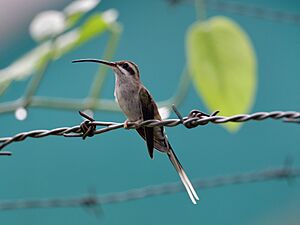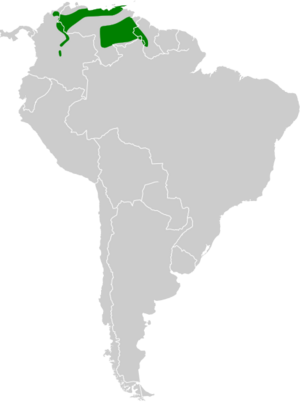Sooty-capped hermit facts for kids
Quick facts for kids Sooty-capped hermit |
|
|---|---|
 |
|
| Conservation status | |
| Scientific classification | |
| Genus: |
Phaethornis
|
| Species: |
augusti
|
 |
|
The sooty-capped hermit (Phaethornis augusti) is a type of hummingbird. These tiny, fast-flying birds are part of the Trochilidae family. You can find them in countries like Brazil, Colombia, French Guiana, Guyana, Suriname, and Venezuela.
Contents
About the Sooty-Capped Hermit
The sooty-capped hermit is a small bird, usually about 14 to 15 centimeters (5.5 to 5.9 inches) long. Males weigh between 4.5 to 6 grams (0.16 to 0.21 ounces). Females are a bit lighter, weighing 4 to 5 grams (0.14 to 0.18 ounces).
These hummingbirds are mostly grayish-brown on their upper bodies. They have a reddish-brown area on their lower back and tail feathers. The feathers next to their inner tail feathers are longer than the others. All their tail feathers have white tips. Their undersides are gray.
Their face has a black "mask" that looks like a bandit's mask. Above this mask, they have a white stripe over their eye. They also have a white stripe on their throat. Some sooty-capped hermits have slightly different colors on their chest or tail feathers.
Where Sooty-Capped Hermits Live
Sooty-capped hermits live in several South American countries. You can find them in parts of Venezuela, Colombia, Guyana, Brazil, French Guiana, and Suriname.
They live in different areas, including:
- The Coastal Range and eastern Andes mountains in Venezuela.
- The eastern slopes of Colombia's Eastern Andes.
- The isolated Sierra Nevada de Santa Marta mountains in northeastern Colombia.
- The flat-topped mountains called tepuis in southern Venezuela, western Guyana, and Brazil's Roraima state.
These birds usually stay in one place. However, some might move up or down mountains depending on the season.
What Sooty-Capped Hermits Eat
Sooty-capped hermits are "trap-line" feeders. This means they visit a regular path of flowering plants to drink nectar. Nectar is a sweet liquid that gives them energy.
They also eat small arthropods, which are tiny creatures like insects or spiders. Sometimes, they have been seen catching these tiny bugs inside buildings.
Sooty-Capped Hermit Reproduction
Sooty-capped hermits build cone-shaped nests. These nests are often made of moss and spider webs. They might also have pieces of dried mud on the outside.
A typical nest hangs from a single strong strand of spider silk. One nest was found hanging from a nail in a storehouse. These birds can reuse their nests several times within one breeding season. Females usually lay two eggs at a time. In Venezuela, active nests have been found between February and July, and also from September to December.
How Sooty-Capped Hermits Communicate
The sooty-capped hermit's song is a repeating tune. It sounds like "tsee-tsee-tsee-sew-sew....tsee-tsee-tsee-sew-sew...". It starts with 2-3 high notes, followed by 2-3 slightly lower notes.
Male sooty-capped hermits sing from a perch at a special gathering spot called a lek. While singing, they wag their tails. They also make a simple "tseet" call.
Conservation Status
The IUCN (International Union for Conservation of Nature) says the sooty-capped hermit is a species of "Least Concern." This means they are not currently in danger of disappearing. We don't know exactly how many there are, but their numbers seem to be steady. They are considered uncommon in some places and common in others. These hummingbirds seem to do well even in areas changed by humans.


